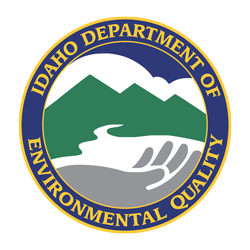DEQ and the Idaho Department of Health and Welfare (DHW) each play a role in identifying, responding to, and monitoring cyanobacteria harmful algal blooms (HABs).
The health advisory map is available on DHW’s Recreational Water Health Advisories web page.
Our staff are responsible for responding to HAB reports from the public, sampling Idaho waterbodies, and analyzing water quality data. We provide sample results to DHW and the public health district in the area where the HAB is reported, and they decide if it warrants a health advisory.
Due to the extensive number of waterbodies in the state, it is not possible for DEQ to monitor them all, at all times. HAB tests can also take up to a week to get back, and HABs can develop or dissipate quickly, particularly in hot weather. For more information about what a HAB looks like, see our Cyanobacteria Harmful Algal Bloom Information StoryMap. If the water looks bad, stay out, and report to our team using the methods below.
Water Quality Test Results
As water quality sample results become available, you will see them in the table below.
County | Waterbody | Sample Date | *Threshold Level | Health Advisory |
|---|---|---|---|---|
Kootenai | Hayden Lake (North Arm) | 11/20/2024 | Below | N/A |
Twin Falls | Salmon Falls Creek Reservoir | 8/28/2024 | Below | N/A |
Twin Falls | Cedar Creek Reservoir | 9/19/2024 | Above | N/A |
Washington | Brownlee Reservoir (Wolf Creek) | 11/20/2024 | Below | N/A |
Blaine | Fish Creek Reservoir | 6/24/2024 | Below | N/A |
Washington | Mann Creek Reservoir | 7/31/2024 | Below | N/A |
Washington | Eagle Bar, Hells Canyon | 10/9/2024 | Below | N/A |
Elmore | C.J. Strike Reservoir (Airforce Marina) | 9/3/2024 | Below | N/A |
Kootenai | Fernan Lake | 11/20/2024 | Below | N/A |
Kootenai | Avondale Lake | 11/20/2024 | Below | N/A |
*For more details on threshold values, please click on “DEQ’s Role and More Bloom Information” below.
Report a Potential Harmful Algal Bloom
Report a potential harmful algal bloom:
- Online form
- By phone: (866) 671-5385
- By email: algae@deq.idaho.gov
Health Concerns
Idaho’s health agencies offer citizens education and advice on cyanobacteria exposures. Contact the Idaho Department of Health and Welfare or your local public health district for health concerns and cyanobacteria information.
This accordion will not appear on the screen
Email us



